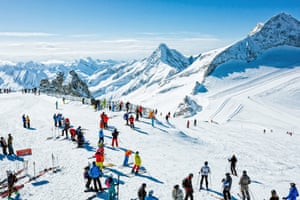
Whether you’re new to skiing or boarding or have been on the slopes pretty much since you could walk, there are certain codes of conduct which should be followed. Should you strike up conversation on a chairlift? When is it OK to take a selfie? Is it alright to wear an 80s ski suit? Neilson Mountain Expert Sarah Watson offers some tips.
The skier in front has right of way
Forget everything you learned in your Highway Code, the rules of the road count for nothing here. The skier in front (lower down the slope) always has right of way over you. It doesn’t matter how slowly they are going or how wide their traverse might be, you don’t have the right to cut them up. “Remember, you were a beginner once too!” says Watson.
Stop somewhere sensible
You might have just spotted a cute marmot or the perfect place for a selfie, but think before you stop on the slopes. “Unless you have fallen or you are helping someone else who has, always stop at the side of the piste,” says Watson. “Also, don’t stop in a blind spot just after the crest of the hill – you won’t be seen and you risk being mown down by someone perfecting their jump. You should also avoid stopping where pistes cross.”
Don’t get stuck in the wrong place
Some ski areas are huge, with several different valleys. If you don’t start making your way back to your “home” resort early enough, you could miss the last lift and be landed with a very large taxi or hotel bill. “I’ve had clients, especially ones who are fairly new to skiing, who have underestimated the amount of time it will take to get back and got stuck, to their cost,” says Watson. “I recommend allowing at least 15 minutes for each lift – sometimes over 30 minutes during peak times.”
Ski Lifts Above Cloudscape Against Clear SkyGettyImages-663783093
FacebookTwitterPinterest
Carry a map, ski at lunchtime, and remember: lifts go up AND down. Photograph: Lars Krafft/Getty
Advertisement
Some lifts go down as well as up
If the weather’s closed in, the snow’s getting icy or you’re simply too tired for one more run, many lifts will carry people down the slopes as well as up. “Fatigue is a factor in many accidents,” says Watson. “There’s no shame in taking the gondola down if you feel like it.”
‘It’s really bonding when we’ve all spent the day on the slopes’: how to introduce your children to a snow holiday
Paid for by Neilson
Read more
Always carry a piste map
You might be used to Google Maps or the like for finding your way around, but when it comes to skiing, it pays to be old school. Not only will the piste map help ensure that you don’t inadvertently have to pick your way down a black run when you’ve never ventured off a blue before, it can help in an emergency. “Piste maps have the emergency number you should call if you come across an accident or need help for any other reason,” says Watson. “112 will work, but there will be an in-resort phone number on the map which is likely to get help to you faster.”
Say hello on chairlifts – or don’t
“Whether you should strike up conversation on lifts depends on the situation,” says Watson. ‘I think it’s nice to at least say hello if it’s just you and someone else on the lift – but bear in mind they may not speak your language. I find people are usually happy to chat, but it’s far from obligatory.”
Ski at lunchtime
Most mountain restaurants are open all day. If you want to enjoy quieter slopes, have your lunch early or late and carry on skiing or boarding while everyone else is still digging in to their tartiflette. “Alternatively you can join one of Neilson’s Mountain Expert groups,” Watson suggests. “We can show you where the quietest slopes are at any time of day, as well as the best restaurants.”
Don’t stand on people’s skis in lift queues
You’d think this etiquette rule would be obvious and not need stating, but sadly that’s not the case. Just don’t do it. It’s annoying. Similarly, watch what you are doing with your poles while you’re in the lift queue – there’s no need to use them to point out where you’re headed. Your finger will work just fine.
Watch your speed
There’s a time and a place for excessive speed, namely, during races. Going fast on uncrowded pistes is generally OK as long as you remain in control. Hooning down the nursery slope to show the beginners how much better you can ski than them is not, however.
Wear the right clothes
Your 80s ski suit is fine – at least people will be able to see you easily. But bear in mind mountain weather can change quickly, so ensure you have layers to put on or take off, snow goggles in your pocket even when the sun is out, and ideally carry water.
0 Comments
Post a Comment